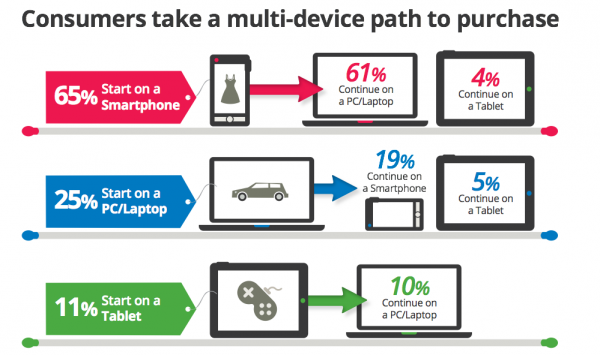The following is a guest post from Luke Rees, a digital marketing executive at AccuraCast who writes extensively about technology, ecommerce, and trends in the search market industry.
Luke explores the importance of not only omnichannel alignment but also of considering human-to-human interactions as part of an omnichannel strategy. Also, he does so in British English (recognise), which adds a little European flavor to the blog!
And now, Luke…
The age of digital retail still presents a number of challenges for businesses, and especially for customer service teams. Greater insight into online behaviour means we can understand our customers’ needs in depth – plus, we can track and engage with them in real time. But what about the human touch? It would be a mistake to assume all customer interactions only happen online.
Despite ever growing trends in digital, the best businesses still recognise the value of the human voice. Research from ResponseTap, a call-based marketing automation company, found that 64% of people get frustrated when they are only able to interact with a company online, and 70% find that speaking to an operator on the phone gives them peace of mind and confidence that they are getting exactly what they want.
These findings support the notion that the human voice offers a vital element in the formation of brand identity, as a reassuring and helpful voice helps to develop and strengthen loyalty between business and customer. Life is about human interactions and the business that masters this today, wins.
The main thing marketing in the digital age needs to offer consumers, is choice. Selling has become more informal, sociable, and subject to change, and as a result the customer purchasing path has never been more complex.
Think of all the ways it is now possible to interact with a brand before making a purchase: you might receive a flyer in the post, for example, which motivates you to browse the company’s website on a desktop computer. The next day you might move to a mobile device to see their social media profile and check what they’ve been posting about. A few days later you could receive a notification on your tablet offering you a special deal, which leads you to call the number on the banner ad. After speaking to a sales associate, feeling satisfied about the product and the brand, you finally decide to make a purchase whilst on the phone.
Check out this infographic from Telco 2.0 Research on the different paths consumers take before making a purchase:

Having so many devices and channels available for interaction is a luxury for the consumer but a challenge for marketing and customer service teams. How do we ensure that all paths integrate fluidly? Also, and most pertinently, how do we guarantee the offline experience matches the level of service we experience in the online world?
True omnichannel distribution works when all devices and channels match up to give a customer the impression of a single, seamless purchasing journey, from initial impression to final purchase.
We know how important it is to offer this kind of service because, according to a report from Aberdeen Group, companies with omnichannel customer care strategies have 91% better year-over-year (YOY) customer retention rates than those that don’t. These companies also achieve on average an 8.5% YOY improvement in first contact resolution, a 7.5% YOY decrease in average cost per customer contact and a 9.5% increase in YOY revenue.
The phone call is one of the most effective channels for providing quality customer service and for driving brand advocacy, however, being an offline channel, it is also one of the most challenging to integrate into your omnichannel strategy.
If you want to do it well, it means focusing on three key practices:
The great thing about online advertising is the unprecedented access we now have to customer data. Analytics programmes, like Google Analytics, allow us to track things like search queries, page impressions and clicks, so that it becomes possible to build complete profiles of our customers and to respond to their needs.
Make the most of this data as it is the most valuable resource you have when a customer moves offline. If your contact centre is able to view each customer’s digital footprint, and already has a clear idea about their individual needs before picking up the phone, it makes the sales agent much more prepared to deliver great customer service.
Call tracking software is now essential for contact centres that want to go omnichannel. Without the technology your agents are essentially working blind – not able to offer much better service than the dreaded “press 1 for…”, “press 2 for…” automated response.
There are a number of services that put your call operators “in the know” before they’ve gone to pick up the phone. “Call whispers”, for example, feed your operators insights into a customer’s digital footprint before a call connects. This saves time spent finding this information out on the phone while at the same time impresses callers with your agent’s ability to predict their query.
If contact centres truly want to be the most effective lead-converting channel on the purchasing path, they can’t work alone. Omnichannel distribution is about taying connected and bridging the gap between online and offline to create a seamless brand experience.
By enhancing the traditional call-centre with new technologies, like call whispers and Google Analytics, it becomes possible to make the phone an integral part of your omnichannel strategy. It means your centre agents are able to offer levels of service that are all but equal to their counterparts in the physical store.
Comments are closed.
© 2011-2025 CTS Service Solutions, LLC.
All rights reserved.
Legal Information | Privacy Policy
How to Cite this Site
Pingback: 128: Christianne Harder, Fan Engagement
Pingback: 244: (Tip) The Magic of 1-to-1 Experiences
Pingback: 262: Ecommerce Still Not Getting It Right